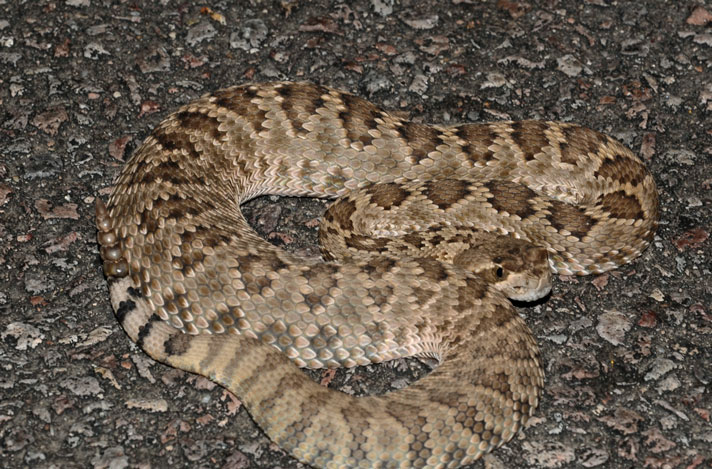Is the road surface considered to be a natural habitat for photos?
Question: Road cruising for herps with my son is a favorite pastime. We often photograph what we find, even at night, and have quite an assortment of species to show. Is the road surface considered to be a natural habitat for photos? Even though they don’t look very natural, would those pictures be considered okay to list as “as found”?
Jackson Mills, Irvine, Calif.

bill love
Mojave rattlesnake (Crotalus scutulatus) on a paved road surface, a less-than-spectacular view of a species commonly seen when road cruising for herps at night.
Answer: In situ is the phrase you’re referencing above. It means in position, theoretically undisturbed from the way it was first found or seen in nature. The degree of non-disturbance varies from person to person regarding herp photography because it’s nearly impossible to encounter a herp, get a clear close-up photo and not alter its behavior at least slightly. The moment most herps detect human presence, they react in some way, no matter how subtle. This particularly applies to specimens found on roads that virtually always turn their attention toward their antagonist or hasten their flight to escape.
Want To Learn More?
Herping California's Mojave Desert For The Desert Tortoise
Animals on road surfaces are technically in situ when discovered there while road cruising, but most people would argue that the dead zone of road surfaces do not represent true natural habitat. Roads are merely obstacles to cross and expose reptiles to danger from predators and vehicles out in the open. The exception is when they occasionally pause on the blacktop to soak up retained heat.
I frequently see herp photos taken while looking down on the herp as it sits on a road. Personally, they bore me to death because they’re so bland and uninformative about the environs of where the creature lives. If you get down at eye-level with your subject, you may also be able to include some of the habitat just off the road in the photo, at least during daylight hours. This makes them much more interesting.
Road shots can have value, despite my dissing them. They document a species’ existence at a certain locale at a certain time—useful information to museums and wildlife departments. Naturally, those photos are also memories of what you saw while out herping.


